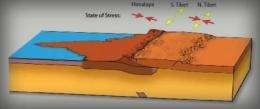New research suggests strong Indian crust thrust beneath the Tibetan Plateau

For many years, most scientists studying Tibet have thought that a very hot and very weak lower and middle crust underlies its plateau, flowing like a fluid. Now, a team of researchers at the California Institute of Technology (Caltech) is questioning this long-held belief and proposing that an entirely different mechanism is at play.
"The idea that Tibet is more or less floating on a layer of partially molten crust is accepted in the research community. Our research proposes the opposite view: that there is actually a really strong lower crust that originates in India," says Jean-Philippe Avouac, professor of geology and director of Caltech's Tectonics Observatory.
These insights lead to a better understanding of the processes that have shaped the Himalaya Mountains and Tibet—the most tectonically active continental area in the world.
Alex Copley, a former postdoctoral scholar with Caltech's Tectonics Observatory, along with Avouac and Brian Wernicke, the Chandler Family Professor of Geology, describe their work in a paper published in the April 7 issue of the journal Nature.
Tibet and the surrounding Himalaya Mountains are among the most dynamic regions on the planet. Avouac points out that underground plate collisions, which cause earthquakes and drive up the Himalaya and Tibet, are common geological processes that have happened repeatedly over the course of Earth's history, but are presently happening with a vigor and energy only found in that area.
Even though the elevation is uniform across the Tibetan Plateau, the type of stress seen within the plateau appears to change along a line that stretches east-west across the plateau—dividing the region into two distinct areas (southern and northern Tibet, for the purposes of this research.)
The researchers propose that a contrast in tectonic style—primarily east-west extension due to normal faulting in southern Tibet and a combination of north-south compression and east-west extension due to strike-slip faulting in northern Tibet—is the result of the Indian crust thrusting strongly underneath the southern portion of the Tibetan Plateau and locking into the upper crust. Strike-slip fault surfaces are usually vertical, and the rocks slide horizontally past each other due to pressure build-up, whereas normal faulting occurs where the crust is being pulled apart. They believe that the locked Indian crust alters the state of stress in the southern Tibetan crust, which can explain the contrast in the type of faulting seen between southern Tibet and northern Tibet.
To test their theory, the team performed a series of numerical experiments, assigning different material properties to the Indian crust. The simulations revealed evidence for a strong Indian lower crust that couples, or locks in, with the upper crust. This suggests that the "channel flow" model proposed by many geophysicists and geologists—in which a low-viscosity magma oozes through weak zones in the middle crust—¬is not correct.
"We have been able to create a model that addresses two long-standing debates," says Copley, who is now a research fellow at the University of Cambridge. "We have constrained the mechanical strength of the Indian crust as it plunges beneath the Tibetan Plateau, and by doing so have explained the variations in the types of earthquakes within the plateau. This is interesting because it gives us new insights into what controls the behavior of large mountain ranges, and the earthquakes that occur within them."
According to Wernicke, the results have motivated the team to think of ways to test further the "weak crust" hypothesis, at least as it might apply to the active tectonic system. "One way we might be able to image an extensive interface at depth is through geodetic studies of southern Tibet, which are ongoing in our research group," he says.
More information: The Gordon and Betty Moore Foundation funded the research, described in the Nature paper, "Evidence for mechanical coupling and strong Indian lower crust beneath southern Tibet."
Provided by California Institute of Technology

















